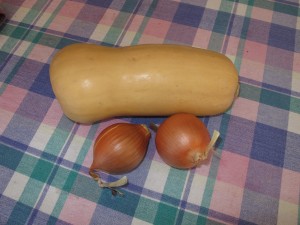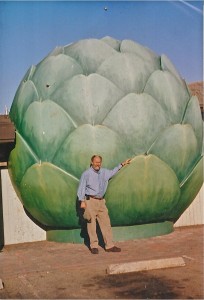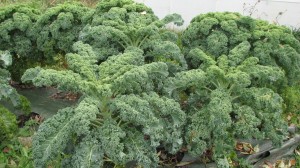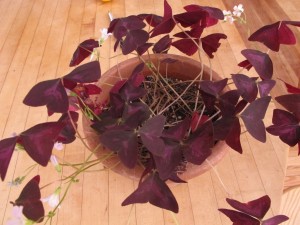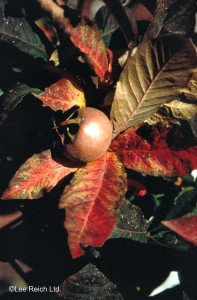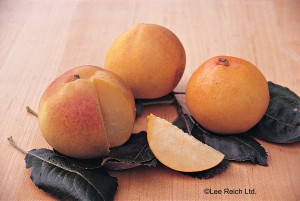A Winter Meal from the Garden
Technically, spring arrived on March 20. Most years I have snowdrops blooming on a south-facing hillside by early March, and some Glory-of-the-Snow in blossom by now. Not this year. Snow is still deep on my property, and nights with temperatures near zero have been common. Sigh. But I have a few plants started by seed growing under lights, to keep me chipper.
I also continue to eat from my garden. Yes, all those frozen and stored veggies keep me well fed and looking forward to this year’s vegetable garden. One of the best vegetables I grow is the butternut squash, specifically one called ‘Waltham’. It stores well in a cool, dry spot and is full of vitamins and energy. I recently made a butternut and apple soup with one, and it was fabulous. I got the idea from Anne Yates of Anne’s Country Store in Plainfield, NH, which has a great deli. She told me what she did (without any measurements), and I created my own version of it while also trying to use just home-grown veggies.
Usually I steam squash to cook it, but Anne said she roasted hers, so I tried that approach. I cut a large butternut in half lengthwise, cleaned out the seeds and lightly oiled the cut surface. I placed it face down on a cookie sheet and roasted at 350 degrees for an hour or more. This caramelized the sugars and made the squash even sweeter than it was. I scooped out the meat from the skin; it yielded about 3 cups of meat.
From my freezer I took out a jug of frozen apple cider. I bring apples to my local orchard in the fall, and have them press my apples (for a price) and put the cider in plastic half gallon jugs, which I freeze. I added cider (a quart in total) to the squash meat in my food processor and pureed it in a few batches.
Although I do grow fresh ginger in pots, and have some I could have harvested, I had some grocery store ginger that I peeled and chopped for this soup. I prepared a quarter cup of chopped ginger, which I then sautéed with 2 cups of chopped onions at low heat until the onions were clear and somewhat caramelized. After cooking the onions and ginger, I blended them in the processor, and added it to the squash and cider which was simmering on low heat.
Next, I cleaned up the last of my carrots from the garden that were starting to look wrinkly and bedraggled in my vegetable drawer. I had about 2 cups of carrots, so that is what I used. Of those, some I added to the soup as rounds, some I blended briefly in the processor. I added a cup of chicken broth at this time, though vegetarians could omit this.
Last fall was great for apples, so I froze lots of sliced apples. For this soup I used 4 cups of frozen apple slices with the skins on. I cooked them with a little water in a saucepan until soft, and then blended them into an applesauce-like mixture in the food processor. That produced about 2 cups of applesauce – which you could substitute here if you didn’t have fresh or frozen apples.
After I added the applesauce to the soup, I added a light sprinkle of nutmeg and some salt and pepper. And no, I don’t produce or collect the nutmeg, salt or pepper. There is just so much one can do to eat locally.
When it comes to growing butternut squash, I like to start seeds in the house a month before it is time to put them in the garden. I say a month because conventional wisdom is that squash family plants (including cukes, pumpkins, and melons) don’t like to have their roots disturbed. An 8-week old squash plant has a big root system and might be stunted or slowed in growth when transplanted into the garden. I plant in June after the soil is plenty warm.
The main reason I start squash indoors instead of planting seeds directly in the garden is this: there is a terrible insect pest, the striped cucumber beetle, that loves the tender first leaves of any squash-family plant. They are active at night, and will eat off the first 2 leaves of a young plant, killing it. But a 4-week old plant will have enough leaves to survive being chewed on by a few beetles.
You can also cover your seedlings with something called row cover or Reemay. It is a breathable fabric that physically keeps the beetles off the seedlings – unless they come up under it (they live in the soil). But I remove the row cover when the vines blossom – they need insects for pollination.
So try making this soup. The ginger gives it quite a kick, but next time I might add some of the hot pepper powder I make each year. And think about growing Waltham butternuts. They take some garden space (I allocate a 5-by 5-ft space for 3 plants) but are very productive – and tasty, too!
Henry’s Web site is www.Gardening-Guy.com. He is the author of 4 gardening books and a children’s fantasy-adventure about a boy with a mustache and his sidekick, a cougar.
Vegetables as Art
I would hazard a guess that if you toured an art museum, the artwork depicting flowers would outnumber the art showing vegetables by ten to one. Or maybe a hundred to one. Flowers? Georgia O’Keefe and her poppies spring to my mind, Monet had his famous paintings of Giverny with its water lilies. Van Gogh had his sunflowers. And so on. But few painters have focused on kohlrabi or lettuce. And why is that? Vegetables are as beautiful as flowers if properly grown and displayed.
I was recently at the Rhode Island Flower Show and was struck by the artwork of Bill Chisholm of Somerville, Massachusetts (www.billchisholm.com). He had big, bold paintings for sale of vegetables and fruits. I bought a big tomato, a smaller artichoke and a delightful clove of garlic. I hung them in my kitchen, next to the stove. He paints in oil, and then has reproductions printed on canvas using a technique called giclée. The canvas is stretched on wood frames, just like an original, but at a small fraction of the price.
Much of my life is devoted to my vegetable gardens in the spring, summer and fall. I start seeds now, indoors. I baby the infants outdoors in May and June. I harvest and process the food much of the summer and all of the fall. So now, in winter, it’s nice to see veggies on the wall – in addition to those in the freezer. My new art got me thinking about the veggies we will plant this summer.
As you plan your garden this year, think about planting veggies in artistic ways. Choose cultivars for color and leaf texture, and plant them as you would if you were planting a flower garden – or creating a painting. Here are some of my favorites;
I love lettuces. They come in so many colors and leaf textures. I start lettuce in the house in April and May in 6-packs, each week starting a couple of different varieties. I plant green leaf lettuce, red lettuce, lettuce of multiple hues. In the garden I like to space lettuce six inches apart so that each head reaches full size, and is not crowded. But I like to interplant reds with greens, frilly lettuces with shiny leafed-lettuce. Arugula with Romaine or Oakleaf – and so forth.
I get seeds from numerous sources. Renee’s Seeds (www.reneesgarden.com) packages lettuces in pairs or trios of colors. This allows you to create a colorful array of leaf colors with just a package or two. Johnny’s Selected Seeds has an amazing array of lettuce seeds aimed not only at the homeowner, but also the CSA manager and farmer. In their catalog are a few pages showing the diversity of leafs you can work with.
Of the purple-leafed veggies, one of my favorites is orach. This is not a lettuce at all, but a relative of the amaranths, and is sometimes called “summer spinach”. It doesn’t bolt the way spinach does, and can get to be 3-4 feet tall. It will self sow if you let it – I allow a few plants to get big and make seeds, and it comes back each year in my garden. I use if in salads, but I’ve read that it is also good as a cooked green. Available from Johnny’s Seeds.
Other gorgeous vegetables include purple kohlrabi, eggplants, artichokes, and cauliflower. Visitors to my garden look at kohlrabi and seem to ask the same question: “What is that? A space alien?” The plant is fat globe that sits on the soil surface and sends up “arms” from the bulb, with leaves on top the arms.
For sheer production value, you can’t beat a variety of kohlrabi called ‘Kossak’ from Johnny’s Seeds, which produces globes bigger than softballs. But the purple-skinned ones, while smaller, are my favorites for their beauty. Renee’s Seeds sells a package of mixed purple and green varieties. I chop up kohlrabi and use it is salads and stir fries. It’s crisp and mild flavored, with a bit of a cabbage taste. They are fast-growing and should be started by seed in the garden.
Cauliflowers can be gorgeous, too. I have grown a purple cauliflower variety but have to admit that, like most cauliflowers, it is awfully fussy. If the soil is too wet or too dry, the plants get big but don’t produce anything but little buttons – not the big heads you see in the grocery store – or want to eat. And the purple color fades away on cooking.
Artichokes are beautiful plants, but take a long time to grow. In California they are perennials, but not here. This year I started a few seeds in January, but little plants are sometimes sold at good garden centers if you haven’t started any yet. I grow a couple of plants each year mainly for their looks and get a few artichokes to eat, but they are quite small. Some years ago I visited the Giant Artichoke Restaurant in Castroville, CA. It had a sculpture of an artichoke that towered over me that I remember fondly – too bad I can’t have one like it in my garden.
So as we move towards spring, think about the art value of your veggies and create your own living artwork. Tasty can be tasteful and pretty, too.
In addition to writing, Henry Homeyer teaches pruning to homeowners. He can be reached at henry.homeyer@comcast.net. He lives in Cornish Flat, NH.
The Irish Gardener
My great-grandmother took the boat from Ireland to Boston in the latter part of the 1800’s. Dobbie, as we called her, got a job as a cook at Wellesley College. That was a bit ironic because she was, in my memory, a wonderful person but a horrible cook. She never made me anything that I can recall eating with pleasure. Even her boiled eggs – usually a favorite of mine- were runny and disgusting.
So, despite the fact that I am one quarter Irish, for a long time I never paid much attention to Irish food. Not so any more. With St Paddy’s day just around the corner, I will soon be cooking up a big pot of colcannon, one of the great comfort foods of all time. It’s a wonderful combination of potatoes and kale – foods that I still have from last summer’s garden.
As a gardener and a chef I appreciate the value of potatoes, especially potatoes from my own garden. Potatoes come in as many colors and flavors as tomatoes. I grow potatoes with flesh that is white, yellow, pink and purple. I store and save potatoes, and once I went about 20 years without buying a potato to eat or plant. I just started this year’s planting with last year’s potatoes and I stopped eating potatoes when I ran out – until the next crop came in.
But back to colcannon. It is a potato dish I always eat on St. Patrick’s Day. It is easy to make and tasty to eat. I generally use a white potato such as the Kennebec, which is also my most productive variety. One chunk of potato planted can yield up to 5 pounds of potatoes.! They grow big and are great for mashing. The other main vegetable in colcannon is kale, which I grow in quantity and freeze for winter use. I like a variety called Winterbor which is readily available by seed or as seedlings at your local garden center. Here’s how to make a nice Irish side dish:
Ingredients:
2-3lbs of white potatoes
5-6 Tablespoons butter
3 cups kale, fresh or frozen, chopped finely & lightly packed in a measuring cup
½ cup onion finely chopped, or 3 green onions (including the greens)
1 cup whole milk or light cream
Method:
- Peel and boil the potatoes until they will fall apart when poked with a fork.
Drain. - Sauté onions and kale in the butter in a heavy pot on medium heat for 3 to 5 minutes.
- Add potatoes, stir.
- Add the milk (or cream for sheer decadence) and mash well using an old fashioned potato masher, not an electric mixer.
- Add salt and pepper as desired.
But on with the Irish theme. The rest of the meal should be Guinness stew, but that’s not from my garden, so you’re on your own for that. But as a centerpiece on St Patrick’s Day there should be a plant that screams “Irish”. The shamrock? The true Irish shamrock is a type of clover (Trifolium dubium) that is very hard to grow indoors and is rarely available even from florists and nurseries. What you can grow as a house plant is a type of wood sorrel commonly called oxalis. It looks like the Hallmark version of a shamrock.
Oxalis is a nice house plant that comes in green and maroon-leafed varieties – though for St Patrick’s Day green is the proper selection. There are some 300 species of oxalis. Mine do well in a bright window – I have 2 of the maroon-leafed ones in bloom right now. In the summer they thrive on my somewhat shady deck. The light pink flowers are small and reach up above the leaves on thin stems. The leaves fold up at night time.
One of the great things about oxalis is that it is nearly impossible to kill by under-watering it. The leaves may shrivel up and die off, but if this happens, just give it a rest –which I have read it likes – and it will bounce back when you start watering it a few weeks later.
If you have an oxalis, you can divide it easily by separating the corms (the thickened roots) and planting pieces of them in new pots with fresh planting medium. Like most houseplants, oxalis does not do well if the roots stay constantly wet. I have planted mine in potting soil enriched with compost. I find a 50-50 mix is good. I have learned to judge dryness of the soil by lifting the pot. The surface may look dry, but if the pot is heavy there is still plenty of moisture down below.
Whether you have some Irish in you or not, grow potatoes and kale this year. Both are supremely easy. But it’s too cold to think about that now – except as ingredients in colcannon. Bon appétit!
Henry Homeyer is the author of 4 gardening books and a children’s fantasy-adventure about a boy and a cougar. His Web site is www.Gardening-guy.com.
Growing Your Own Fruit
Most mornings in winter I start my day with a bowl of oatmeal. That can get pretty dull, so I liven it up with a variety of fruits, most of which I grew myself and preserved either dried or frozen. Add some cinnamon or cardamom and a few nuts, and bland becomes bodacious. In my freezer I have blueberries, elderberries, blackberries, plums, apples, raspberries and a few peaches that I got by trading some apples with a friend. So if you’re bored with breakfast, do some studying now about the various fruits you might grow, and plant them this summer.
Much of what I know about gardening comes from practical experience: ask a good gardener, for example, what kind of peach tree she grows, plant one, and see how it does. Try again if the first one dies. But I also depend on reading good books on gardening, and now, while there is still snow on the ground, I spend considerable time reading.
I have two books on fruit growing that I like a lot. The first, written in 1992 by Lewis Hill of Greensboro, Vermont, is a classic: Fruits and Berries for the Home Garden. Lewis was a friend of mine (he passed away in 2008) and a Vermonter to the core: quick –witted, hardworking, and curious. He grew up on a dairy farm and only had a high school education, but with his wife Nancy, he wrote 16 excellent gardening books. His book on fruits and berries is full of good information but also entertaining. It has recently been updated, I just learned, by University of Vermont professor Len Perry as The Fruit Grower’s Bible.
The other fruit book I like is Lee Reich’s Grow Fruit Naturally: A Hands-On Guide to Luscious, Homegrown Fruit, which came out in 2012 and is full of color illustrations and good drawings. Like Hill, Lee Reich is opinionated, thorough, and has many years of experience. Lee has a PhD in horticulture and lives in upstate New York.
Reich’s book introduced me to two fruits hardy for Zone 5 (possibly even Zone 4) that I have never grown or tasted: the medlar and the shipova. The medlar is a small tree that is self-fruitful, meaning that one tree is all that is needed for pollination. According to Reich’s book, the medlar blossoms open late enough to almost never be bothered by spring frosts. The fruit keeps well and is very tasty. So why have I never heard of one? Reich writes, “The flesh, when ready for eating, is brown and mushy and lacking visual appeal.” It also needs “bletting” or ripening on a shelf in a cool room, the cooler the better.
The Shipova is actually a hybrid made from two different species, a type of mountain ash (Sorbus aria) and the European pear. Reich lists it as a Zone 4 plant, so it is hardier than the medlar and should survive my New Hampshire winters easily. It produces pear-like fruit on a tree that can grow to 20 feet, or if grafted on a suitable rootstock, only 8 feet tall. He says that are ready for harvest in mid-summer. Unlike the medlar, the fruit does not keep well – but it is attractive to the eye and tasty, too. I called Lee, and he said the fruit tastes similar to a pear.
Reich made it clear that fruits like the medlar and shipova are not often sold at our local nurseries, so I went on-line to see where they are available. Raintree Nursery in Morton, Washington (http://www.raintreenursery.com) had both for sale. In the back of Reich’s book there is a list of nurseries that sell fruit trees, including St Lawrence Nurseries in Potsdam, NY which has lots of cold hardy trees that can be ordered bare root until April 10.
Lee Reich’s book is just chockfull of tidbits that are useful. He explains, for example, labels on pesticides: ‘caution’ means the material is slightly toxic or relatively nontoxic. ‘Warning’ means moderate toxicity, and material marked ‘danger’ might kill you – even in small quantities. Lee is a proponent of organic techniques, but points out that even pesticides approved for organic growers can have severe side effects. He notes that nicotine sulfate is an extract of tobacco that is “organic” but has a danger label. It’s important to pay attention to warning labels whether you are using organic pesticides or not.
I also like the fact that Reich’s Grow Fruit Naturally has specific cultivars named for the fruits it describes, and offers useful tips such as whether a variety is self-fruitful or not. There is a nice section on pruning and another on proper planting techniques.
Call me a skeptic, but I like to buy trees from local nurseries as it means that the owners probably have grown what they are selling. Still … I love to experiment with new plants, and usually try something new every year. This just might be the year for a shipova or a medlar. I wonder how they are on breakfast cereal?
Henry Homeyer can be reached at henry.homeyer@comcast.net or by writing him at P.O. Box 364, Cornish Flat, NH 03746.



